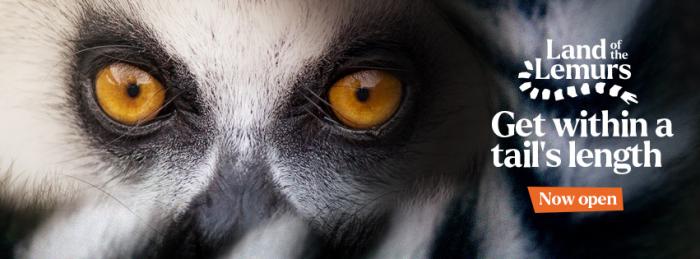Monarto Safari Park | Open Range |

Monarto Safari Park is the largest safari experience to exist outside of Africa.
Spanning more than 1,500 hectares and home to more than 50 species of exotic and native mammals, birds and reptiles, you can fit every major zoo in Australia inside the Park and still have land left over!
The park is located 60 minutes (70 kilometres) from South Australia's capital city Adelaide and is the gateway to the picturesque Murraylands region. Monarto Safari Park is home to many of Africa's most impressive animals and also one of Australia's largest lion prides and giraffe herds.
Since officially opening to the public in October 1993 as a breeding and pasture area, the park is now home to more than 500 animals roaming in vistas as far as the eye can see. It's an escape from the city that immerses visitors in a natural safari-style setting. Monarto Safari Park is owned and operated by a conservation charity, Zoos SA.
Open Hours & Tickets
Open Hours & Tickets
Monarto Zoo is home to the following species
 Addax (African Mammal)
Addax (African Mammal) African Lion (African Mammal)
African Lion (African Mammal) American Bison (American Mammal)
American Bison (American Mammal) Barbary Sheep (African Mammal)
Barbary Sheep (African Mammal) Blackbuck (Asian Mammal)
Blackbuck (Asian Mammal) Cheetah (African Mammal)
Cheetah (African Mammal) Chimpanzee (African Mammal)
Chimpanzee (African Mammal) Chital Deer (Asian Mammal)
Chital Deer (Asian Mammal) Eland (African Mammal)
Eland (African Mammal) Giraffe (African Mammal)
Giraffe (African Mammal) Greater Bilby (Australasian Mammal)
Greater Bilby (Australasian Mammal) Malleefowl Bird (Australasia)
Malleefowl Bird (Australasia) Meerkat (African Mammal)
Meerkat (African Mammal) Przewalskis Horse (Asian Mammal)
Przewalskis Horse (Asian Mammal) Scimitar-horned Oryx (African Mammal)
Scimitar-horned Oryx (African Mammal) Southern White Rhinoceros (African Mammal)
Southern White Rhinoceros (African Mammal) Yellow-footed Rock Wallaby (Mammal)
Yellow-footed Rock Wallaby (Mammal)Our Aims
Our aim is to establish a centre of excellence of national and international value for the conservation of wildlife and for public education, that provides opportunities for tourism and recreational pursuits in a cost effective manner.
Our Objectives
-:- To develop a high profile, quality resource for the conservation of rare species and endangered animals.
-:- To establish Monarto Zoo as one of the worlds leading protectors of endangered species.
-:- To provide a range of experiences which create a high level of educational opportunities and access for the public.
-:- To provide a focal point for tourism and recreational opportunities and benefits at a local, interstate and international level.
-:- To create a cost-effective, functional and attractive business environment which is financially viable five years after opening.
Facts About the Park
The land is State Government owned, and control was passed to the Zoological Society in June 1983 from the Department of Environment and Planning.
Programs for animal care and farm management was established. Over 150 animals were moved to 160 hectares of fenced paddocks with stock healthy and breeding in their new environment.
In 1990 a new feasibility study was undertaken with major changes of thinking. The result was that Monarto changed from a special-purpose breeding area closed to the public, to an international standard zoo accessible to the public which officially opened in October 1993.
The zoo is surrounded by an international standard quarantine and vermin-proof fence built by a Commonwealth Jobskill project which was complete in March 1993.
Monarto is a biopark in the true sense of the word. It represents a unique blend of a conservation park, national park and zoological park. The principle purpose is to provide a place for the conservation of wildlife both Australian and exotic, and public recreation and education.
Monarto plays a major role nationally and internationally in the breeding programs for rare and endangered species. It is ideal for wildlife from Savannah grasslands and semi-arid habitats of Africa, Asia, South America and Australia. A wide range of species can be held within the park. There are few areas outside of their natural habitats where these species can be bred safely and free from exotic diseases.
The climate is typical of semi-arid areas with hot, dry summers and mild winters. Frosts are rare. There is more winter sunshine than the Adelaide Plains area, and less summer sunshine. Rainfall average is 343mm (13.72 points or 14 inches).
Landcare and Vegetation
Erosion is not so much a problem since the zoo has been managed by the Society. Regeneration of active mallee is helped by a long term revegetation and weed eradication program. Endemic vegetation is most important and large areas are set aside with grasslands in the animal habitats. 120-160 hectares is used for rotational crops of barley, oats, wheat and pea straw which provide feed for the herbivores.
Creek Systems
Two creeks run through the Park and flows are constant over the winter but dry in summer. The ground is saline. Wetlands are being developed along Rocky Gully Creek and Dry Creek which has small ponds attracting native birdlife.
Habitats
Habitats range in size from 5 - 50 hectares of non-irrigated grasslands and groups of trees provide shelter for wildlife. Low visibility and low cost fence barriers are used. Dry moats may be used occasionally between exhibits enabling close contact of the animals without visible barriers. Development and management techniques for low intensity energy minimise the running costs of the project.
Getting Here
The park is located 60 minutes (70 kilometres) from South Australia's capital city Adelaide and is the gateway to the picturesque Murraylands region.
From Adelaide take the Monarto exit off the South Eastern Freeway to the Princes Highway and follow the signs. Approximate travelling time 1 hour - distance approximately 64km from Adelaide CBD to Monarto Zoo.
From the East take the Murray Bridge exit off the South Eastern Freeway to the Princes Highway and follow the signs. Approximate travelling time 15 minutes - distance approximately 14km from Murray Bridge to Monarto Zoo.
❊ Address ❊
⊜ 3401 Old Princes Highway Monarto 5254 View Map
✆ Telephone: 08 8534 4100
❊ What's On ❊
Coming to Monarto Safari Park | Open Range..➼ Monarto Safari Park | Open Hours & Tickets
❊ Web Links ❊
➼ Monarto Safari Park | Open Range
➼ www.zoossa.com.au
➼ www.monartosafari.com.au
❊ Also See.. ❊
➼ Adelaide Zoo
Tags: monarto zoo, open range, adelaide zoos, south australia, tourism
Update Page






